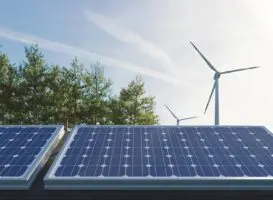Something unexpected happened in England last weekend. For the first time ever, National Grid, the countries primary utility company, reported that the demanded for electricity for homes and businesses was lower last Saturday afternoon that it was that night. That was because the power available from solar panels was so high, thanks to a beautifully sunny Spring day.
 Let’s be clear. National Grid isn’t saying the citizens of the British Isles used less electricity that day. What they are saying it that supply from solar was so high that there was less need for electricity from fossil fuel or nuclear power plants.
Let’s be clear. National Grid isn’t saying the citizens of the British Isles used less electricity that day. What they are saying it that supply from solar was so high that there was less need for electricity from fossil fuel or nuclear power plants.
It sees the solar power generated on the distribution networks — the parts of the grid that benefit from the input of localized solar power — as reduced electricity demand. National Grid called what happened a “huge milestone”. The sunshine meant that solar power produced six times more electricity than the country’s coal fired power stations on Saturday.
Duncan Burt, who manages daily operations at National Grid, said: “Demand being lower in the afternoon than overnight really is turning the hard and fast rules of the past upside down. It’s another fascinating sign of the huge changes we are seeing in Britain’s energy scene.” Electricity demand usually peaks between 4 and 6 pm at this time of year when people return home from work.
According to Chris Goodall, who has written a book about how solar power is transforming energy systems, says March is a good time for solar panels in the UK, due to the angle the sun is hitting them and because they operate better in lower temperatures.
“A sunny day between the equinoxes can now produce a peak of around 9.5GW. At weekends, when demand is low, this will frequently mean solar is producing well over 25% of the UK power need. This drives coal almost completely out of the mix, as it did at the weekend, and depresses gas use,” he said.
Goodall claims that on summer weekends this year, when electricity demand is lowest, the grid will need less than 15% of its power supply from fossil fuel sources. As offshore wind farms are completed and brought online in coming years, he thinks the need for convention electrical generation could fall to zero on windy and/or sunny days during the week when demand is higher.
The solar industry hailed the landmark, saying the government has repeatedly underestimated the technology’s potential. A spokesperson for the Solar Trade Association said: “This milestone shows the balance of power is shifting, quite literally, away from the old centralized ‘coal-by-wire’ model into the hands of householders, businesses and communities all over the UK who want their own clean solar power.”
An independent report commissioned by the STA found the UK’s power network could handle four times more solar capacity than what is avialable today without increasing costs for the grid. Other studies have also concluded that a significant expansion of renewable energy would impose only “relatively modest” costs to integrate into the electricity system.
A government spokesman said: “This government wants Britain to be one of the best places in the world to invest in clean, flexible energy. Solar power is a great success, with over 11 gigawatts of capacity installed in the last five years. That’s enough to power more than 2.6 million homes with clean electricity.” That may be so, but it doesn’t explain why government incentives for the solar power industry have been slashed, leading to a sharp decline in the amount of newly installed solar power since the middle of 2016.
Source: SolarLove. Reproduced with permission.










